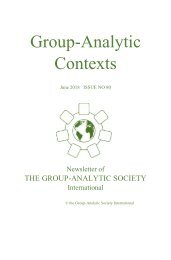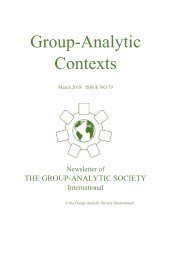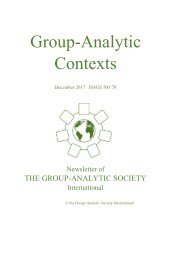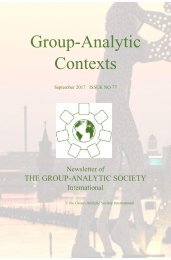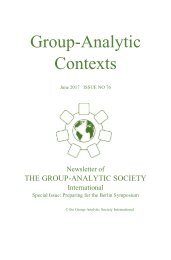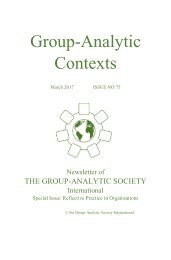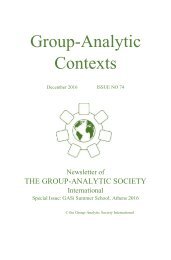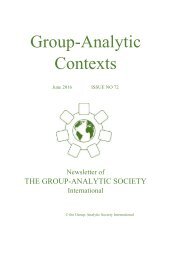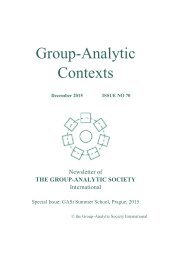Group-Analytic Contexts, Issue 81, September 2018
Newsletter of the Group Analytic Society International
Newsletter of the Group Analytic Society International
Create successful ePaper yourself
Turn your PDF publications into a flip-book with our unique Google optimized e-Paper software.
Newsletter – Autumn <strong>2018</strong> 19<br />
Psychosis and migration: does a correlation exist?<br />
A multitude of retrospective studies since 1930 so far agree that the<br />
impact (and the risk too) of developing psychosis among emigrants,<br />
refugees and asylum seekers is significantly increased in comparison<br />
with the native population, continuing in the second and third<br />
generation (Ødegaard, 1932; Schick M. et al., 2016; Tarricone I. et al.,<br />
2015; Rhodes J.E. et al., 2016; Mandaglio C. & Maierà E., 2014;<br />
Hollander A.C., 2013; Morgan C. et al., 2010; Bradley A.J. & Dinan<br />
T.G., 2010).<br />
The risk of psychosis in first-generation immigrants is almost<br />
three times higher than that of natives (Maltzeberg, 1995). The risk of<br />
psychosis developing among second-generation immigrants is<br />
increased 4-5 times in comparison to the indigenous population<br />
(McGrath, 2004).<br />
Early childhood mental trauma is as much indicative as it is<br />
explanatory for the development of psychosis. Mondelli et al. (2010)<br />
found a significant negative correlation between the number of<br />
stressful life events and cortisol levels in first-episode psychotic<br />
patients, in contrast to the control group. This was attributed to the<br />
excessive load of stressful life events, since 85,7 % of psychotic<br />
patients had experienced a childhood trauma.<br />
A dose-dependent relationship has been described between<br />
traumatic exposure and psychological detriment (Johnson &<br />
Thompson, 2008; Mollica et al., 1998). Stress may be associated with<br />
psychosis by sensitizing people, both at the behavioral and the<br />
neurological level. An example of genes – environment interaction in<br />
psychosis: the vulnerable gene type is more susceptible to the<br />
development of psychosis after environmental exposure in<br />
comparison to the invulnerable type (Moffitt et al. 2005; Winkel et al.<br />
2008). Abuse during childhood correlates with the development of<br />
psychosis during adulthood (Ackner et al. 2013). A number of studies<br />
suggest that emotional abuse and cumulative trauma exposure is<br />
related to psychotic experiences.<br />
Migration related factors potentially associated with<br />
psychopathology are: direct violence, poor living conditions,<br />
humiliation, exclusion and discrimination occurring during the<br />
migration period (violence, lack of water, food, health and basic<br />
services), as well as the pre- (battles, tortures, rape, death or<br />
disappearance of individuals, lack of water, food and health services,<br />
loss of native country and individuals) and post- (racist assaults, gang<br />
violence, retention at refugee camps, exclusion from the host country<br />
infrastructure) migration ones (Migration and health in the European



